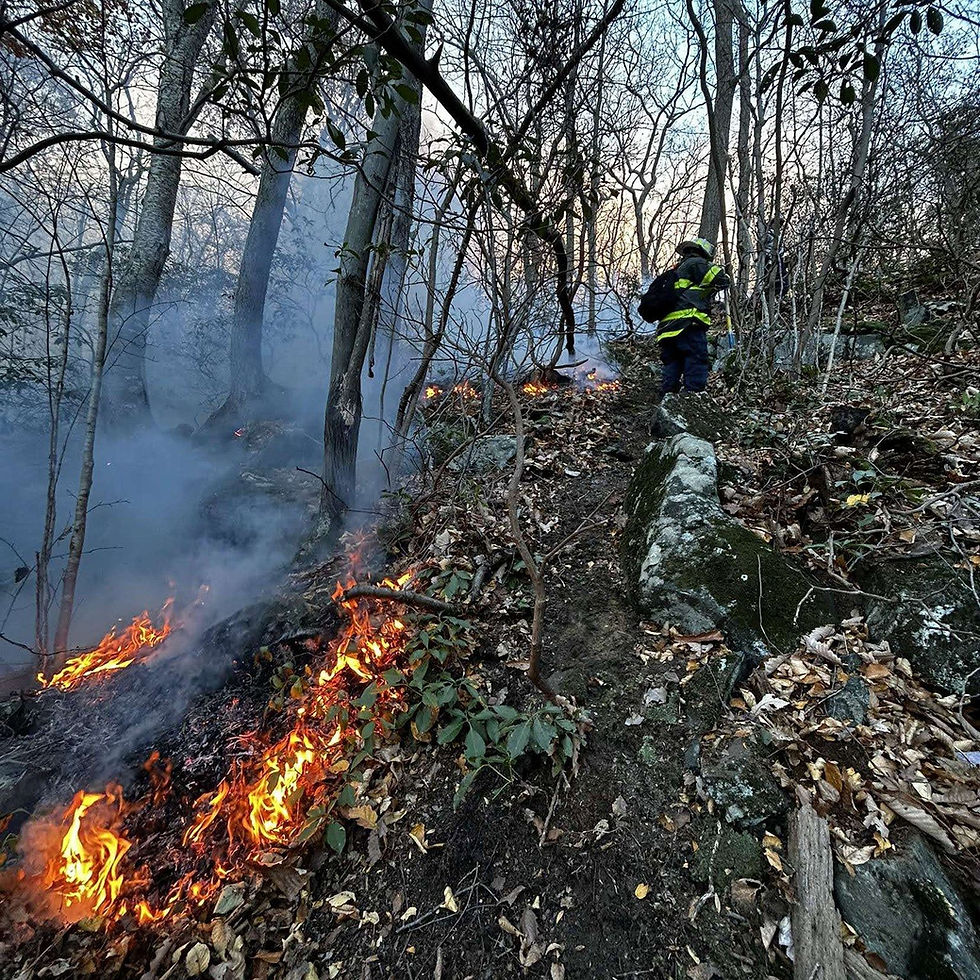
In response to the ongoing threat of wildfires due to severely dry conditions, Putnam County Executive Kevin Byrne implemented a temporary burn ban last week. The ban was announced Oct. 30 at a press conference at the Putnam County Bureau of Emergency Services in Carmel, after a large brush fire in Kent burned 33 acres over six days the week prior.
“Even though we had some light drizzle … our region remains under a ‘high’ fire danger rating from the New York State Department of Environmental Conservation,” said Byrne. “The conditions we’re facing are extremely dry, and we’ve already seen the consequences with numerous brush fires, including the Kent brush fire right here at home.”

The Kent fire, which began Oct. 22 around the Sedgewood Club property, required a large response from more than 10 different fire agencies and was successfully contained and controlled thanks to the tireless efforts of local firefighters and first responders.
“I want to extend our gratitude to the Kent Fire Department, Lake Carmel Fire Department, Kent Police Department, our dispatchers, and all of our neighboring towns’ local fire departments that came in and helped get this under control and keep our residents safe,” said Kent Town Supervisor Jamie McGlasson.
Putnam County BES Commissioner Bob Lipton expressed his thanks for “the bravery and teamwork shown by our local fire departments, law enforcement, and state agencies like the NYSDEC, New York State Police, and the Department of Environmental Protection. The work they did to stop this fire from spreading further was outstanding,” he said. “However, the threat of fire is not behind us. Conditions are still primed for fires to spread rapidly.”
On Oct. 28, Byrne issued Executive Order No. 1 of 2024, which mandates a temporary burn ban across Putnam County. This prohibits all forms of open burning, including campfires, brush burning, and debris fires. It does not include contained gas or coal cooking fires.
“We need everyone’s cooperation to avoid unnecessary risks,” he said. “Until we get consistent rainfall that soaks the ground and improves conditions, this burn ban will remain in place.”
Putnam County Sheriff Kevin McConville emphasized that his office will be working to ensure compliance with the ban, noting that violations could result in penalties.
“This is a serious matter, and we are prepared to enforce the ban if needed to protect public safety,” he said. “Please, be smart. Don’t burn.”
The executive order was initially set to last five days, with the possibility of renewal depending on weather conditions.
For updates and more information about the ban, residents should visit www.putnamcountyny.gov and follow Putnam County’s social media channels.
The Kent brush fire was first reported Tuesday, Oct. 22 at about 6:20 p.m., at 899 Golf Ridge Road – property owned and maintained by the New York City DEP. By Oct. 28, when officials reported the fire to be 100 percent contained and 98 percent controlled and with no more spread, 33 acres were impacted.
Throughout the course of the blaze, fire departments from Kent, Carmel, Lake Carmel, Brewster, Mahopac, Mahopac Falls, Putnam Valley, North Highlands, Patterson, Putnam Valley and East Fishkill worked the scene; as well as the Kent Police Department; NYS DEC forest rangers; NYC DEP Police/Aviation; Westchester County Aviation; EMS/ambulance from Carmel, Putnam Valley, Kent, Patterson Fire Department, and Empress; Putnam County Fire Police, BES and Technical Rescue Team; Kent and Putnam County departments of public works; and New York State Police Aviation.
State Launches New Wildfire Alert System
Gov. Kathy Hochul last week announced a new real-time weather data tool to help inform New Yorkers when there is an increased risk of wildfires. The DEC, and New York State Mesonet at the University at Albany researchers are utilizing data from the university’s statewide weather network to generate daily fire danger ratings to offer more reliable wildfire information and improve public safety.
“Even before wildland fires ignite, accurate data is crucial to deploy resources and advise communities of potential dangers,” said DEC Interim Commissioner Sean Mahar. “This data will help inform a new, easier-to-read map that will benefit New Yorkers when wildfire dangers arise.”
Mesonet is the nation’s most advanced and largest early-warning weather detection system. It features 127 standard weather observation stations that cover the entire state, including at least one in every county and borough. Each site measures temperature, humidity, wind speed and direction, pressure, precipitation, solar radiation, snow depth, and soil information – and offers camera images.
The data is collected in real-time every 5 minutes, feeding weather prediction models and decision-support tools for users across New York. Visit www.nysmesonet.org/weather/firewx.
DEC’s Wildfire Predictive Services also issues and updates a fire danger map that divides New York into multiple fire danger rating areas and rates each on a wildfire risk scale from low to extreme.
The enhanced data collection helps identify the local variability of fire danger across the state, allowing community leaders, emergency managers, and everyday New Yorkers to adapt their activities to prevent fires and reduce damage. Visit https://dec.ny.gov/environmental-protection/wildfires/fire-danger-map.
Recent dry conditions across the state are resulting in a “high” fire danger. This means all fine, dead fuels ignite readily and fires start easily from most causes, including unattended brush and campfires. Fires may become serious and controlling them difficult, unless attacked successfully while still small.
The remainder of the state is at a moderate level of fire danger.
Open burning is prohibited in New York with the following exceptions: campfires or any other outdoor fires less than 3 feet in height and 4 feet in length, width or diameter; small cooking fires; and ceremonial or celebratory bonfires, including disposal of flags or religious items. Only charcoal or dry, clean, untreated or unpainted wood can be burned, and fires cannot be left unattended and must be fully extinguished.

Comments